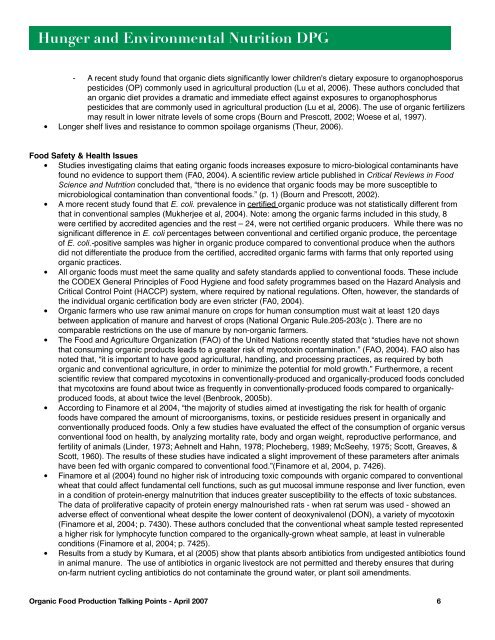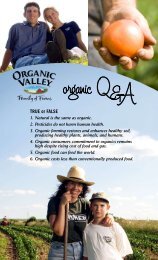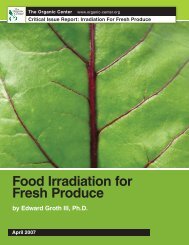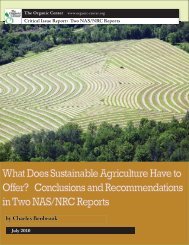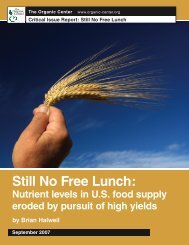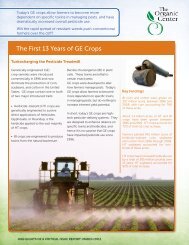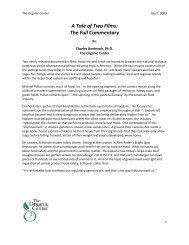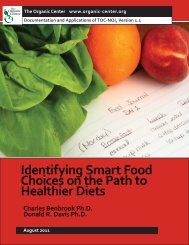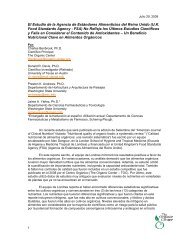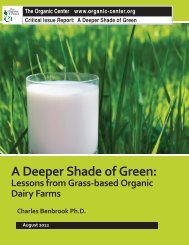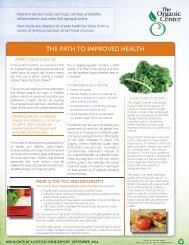Organic Food Production Talking Points - Hunger and ...
Organic Food Production Talking Points - Hunger and ...
Organic Food Production Talking Points - Hunger and ...
You also want an ePaper? Increase the reach of your titles
YUMPU automatically turns print PDFs into web optimized ePapers that Google loves.
<strong>Hunger</strong> <strong>and</strong> Environmental Nutrition DPG<br />
- A recent study found that organic diets significantly lower children's dietary exposure to organophosporus<br />
pesticides (OP) commonly used in agricultural production (Lu et al, 2006). These authors concluded that<br />
an organic diet provides a dramatic <strong>and</strong> immediate effect against exposures to organophosphorus<br />
pesticides that are commonly used in agricultural production (Lu et al, 2006). The use of organic fertilizers<br />
may result in lower nitrate levels of some crops (Bourn <strong>and</strong> Prescott, 2002; Woese et al, 1997).<br />
• Longer shelf lives <strong>and</strong> resistance to common spoilage organisms (Theur, 2006).<br />
<strong>Food</strong> Safety & Health Issues<br />
• Studies investigating claims that eating organic foods increases exposure to micro-biological contaminants have<br />
found no evidence to support them (FA0, 2004). A scientific review article published in Critical Reviews in <strong>Food</strong><br />
Science <strong>and</strong> Nutrition concluded that, “there is no evidence that organic foods may be more susceptible to<br />
microbiological contamination than conventional foods.” (p. 1) (Bourn <strong>and</strong> Prescott, 2002).<br />
• A more recent study found that E. coli. prevalence in certified organic produce was not statistically different from<br />
that in conventional samples (Mukherjee et al, 2004). Note: among the organic farms included in this study, 8<br />
were certified by accredited agencies <strong>and</strong> the rest – 24, were not certified organic producers. While there was no<br />
significant difference in E. coli percentages between conventional <strong>and</strong> certified organic produce, the percentage<br />
of E. coli.-positive samples was higher in organic produce compared to conventional produce when the authors<br />
did not differentiate the produce from the certified, accredited organic farms with farms that only reported using<br />
organic practices.<br />
• All organic foods must meet the same quality <strong>and</strong> safety st<strong>and</strong>ards applied to conventional foods. These include<br />
the CODEX General Principles of <strong>Food</strong> Hygiene <strong>and</strong> food safety programmes based on the Hazard Analysis <strong>and</strong><br />
Critical Control Point (HACCP) system, where required by national regulations. Often, however, the st<strong>and</strong>ards of<br />
the individual organic certification body are even stricter (FA0, 2004).<br />
• <strong>Organic</strong> farmers who use raw animal manure on crops for human consumption must wait at least 120 days<br />
between application of manure <strong>and</strong> harvest of crops (National <strong>Organic</strong> Rule.205-203(c ). There are no<br />
comparable restrictions on the use of manure by non-organic farmers.<br />
• The <strong>Food</strong> <strong>and</strong> Agriculture Organization (FAO) of the United Nations recently stated that “studies have not shown<br />
that consuming organic products leads to a greater risk of mycotoxin contamination.” (FAO, 2004). FAO also has<br />
noted that, “it is important to have good agricultural, h<strong>and</strong>ling, <strong>and</strong> processing practices, as required by both<br />
organic <strong>and</strong> conventional agriculture, in order to minimize the potential for mold growth.” Furthermore, a recent<br />
scientific review that compared mycotoxins in conventionally-produced <strong>and</strong> organically-produced foods concluded<br />
that mycotoxins are found about twice as frequently in conventionally-produced foods compared to organicallyproduced<br />
foods, at about twice the level (Benbrook, 2005b).<br />
• According to Finamore et al 2004, “the majority of studies aimed at investigating the risk for health of organic<br />
foods have compared the amount of microorganisms, toxins, or pesticide residues present in organically <strong>and</strong><br />
conventionally produced foods. Only a few studies have evaluated the effect of the consumption of organic versus<br />
conventional food on health, by analyzing mortality rate, body <strong>and</strong> organ weight, reproductive performance, <strong>and</strong><br />
fertility of animals (Linder, 1973; Aehnelt <strong>and</strong> Hahn, 1978; Plocheberg, 1989; McSeehy, 1975; Scott, Greaves, &<br />
Scott, 1960). The results of these studies have indicated a slight improvement of these parameters after animals<br />
have been fed with organic compared to conventional food.”(Finamore et al, 2004, p. 7426).<br />
• Finamore et al (2004) found no higher risk of introducing toxic compounds with organic compared to conventional<br />
wheat that could affect fundamental cell functions, such as gut mucosal immune response <strong>and</strong> liver function, even<br />
in a condition of protein-energy malnutrition that induces greater susceptibility to the effects of toxic substances.<br />
The data of proliferative capacity of protein energy malnourished rats - when rat serum was used - showed an<br />
adverse effect of conventional wheat despite the lower content of deoxynivalenol (DON), a variety of mycotoxin<br />
(Finamore et al, 2004; p. 7430). These authors concluded that the conventional wheat sample tested represented<br />
a higher risk for lymphocyte function compared to the organically-grown wheat sample, at least in vulnerable<br />
conditions (Finamore et al, 2004; p. 7425).<br />
• Results from a study by Kumara, et al (2005) show that plants absorb antibiotics from undigested antibiotics found<br />
in animal manure. The use of antibiotics in organic livestock are not permitted <strong>and</strong> thereby ensures that during<br />
on-farm nutrient cycling antibiotics do not contaminate the ground water, or plant soil amendments.<br />
<strong>Organic</strong> <strong>Food</strong> <strong>Production</strong> <strong>Talking</strong> <strong>Points</strong> - April 2007! ! ! 6


